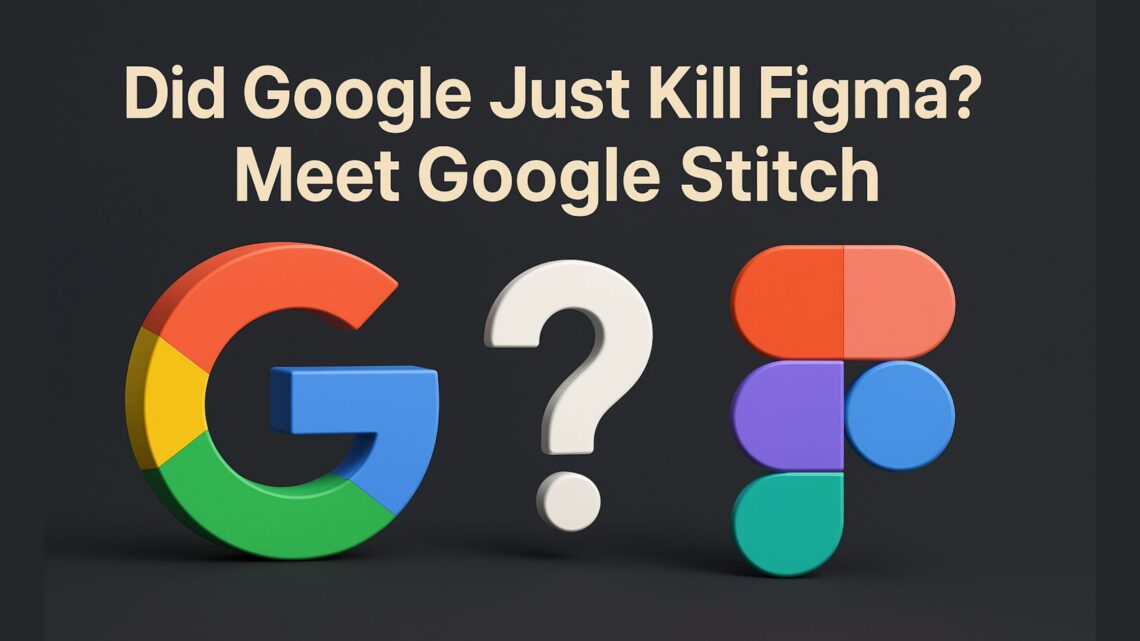When ChatGPT came for writers, designers laughed. “AI can’t understand aesthetics,” they said.
Well… Google just dropped Stitch, and that laugh turned into a nervous gulp.
This isn’t another “AI tool that might help designers someday.” Stitch is out here turning text prompts and sketches into full-blown UI designs , with working code.
Social feeds are already calling it Figma’s final boss. But is it really the end of design as we know it, or just another shiny prototype generator?
Let’s find out if Google Stitch is Figma’s new rival… or just really good marketing.

🎨 What Is Google Stitch, Really?
Think of Google Stitch as that overachieving intern who shows up on day one and suddenly knows how to design, code, and present , all before lunch.
It’s Google’s new AI-powered UI and frontend generator, quietly dropped under Google Labs, and it’s already giving both designers and developers a small identity crisis.
Here’s the magic: you tell Stitch what you want , in plain English.
“Make me a dark dashboard with charts and side navigation,” or drop in a rough sketch.
Within seconds, it spits out a ready-to-use, clean-coded interface. HTML, CSS – the whole shebang.
No dragging rectangles in Figma.
No waiting on developers to “translate” your design vision into code.
No crying over pixel misalignment at 2 AM.
And yeah , it’s powered by Gemini 2.5, which means it’s fast, context-aware, and doesn’t choke when you ask for something slightly human, like “make it aesthetic but not too corporate.”
In short:
Stitch = Text/Sketch → Full UI + Code.
It’s design, meet development. AI is now doing the handoff for you , faster than you can say “component library.”
💥 Why Everyone’s Losing It Over Stitch
Because, for the first time ever, designers and developers are freaking out over the same tool.
Usually, it’s a cold war , designers live in Figma, developers live in VS Code, and handoff day feels like a breakup text: “Hey, I changed the layout a bit. Hope that’s fine.”
But Stitch just kicked open the door and said,
“What if you could skip the whole back-and-forth and get a coded UI right from your idea?”
That’s why the internet’s melting down.
- Designers love it because it saves them from blank-canvas anxiety.
- Developers love it because it gives them clean code they don’t have to decipher from screenshots.
- Founders love it because it turns “Can we get a prototype this week?” into “Give me 5 minutes.”
It’s basically Figma + Copilot + caffeine, wrapped in a clean Google UI.
🚀 Real Talk: Why It’s Blowing Up
- Speed Is Insane
You can go from “idea in your head” to “live preview with code” in under a minute.
No wireframing, no drag-drop drama. - Code That Actually Works
The HTML/CSS it spits out isn’t Frankenstein code , it’s structured, readable, and ready for tweaking.
(Developers are suspicious… but secretly impressed.) - It Bridges the Gap
The eternal designer vs. developer blame game might finally end.
Stitch gives both sides a starting point they can work with , fast, accurate, and editable. - AI Feels… Smart This Time
Stitch doesn’t just auto-fill boxes. It understands layout logic, visual balance, and component reuse.
It’s the difference between “AI made this” and “a designer probably built this.”
So yeah , everyone’s losing it because Stitch isn’t just a tool; it’s a workflow revolution.
The first time you see your words become a working dashboard, you stop asking if AI will change design , and start wondering when it’ll take your job.
⚔️ The Figma Comparison (and the Big Question)
Let’s be honest , Figma walked so Stitch could sprint.
For years, Figma has been the Beyoncé of design tools: clean, collaborative, and basically the reason every UI/UX portfolio looks half-decent.
You can design, prototype, comment, argue, and cry , all in one tab.
But even with all that power, one truth never changed:
Figma designs. It doesn’t build.
That’s where Google Stitch walks in wearing a Gemini badge and a smug smile.
It doesn’t want you to design , it wants you to describe.
You say what you want, and it returns a working layout with actual code attached.
No plugins. No “export as React” drama. Just raw, working front-end magic.
Let’s break it down before the Figma loyalists grab their pitchforks:
| Feature | Google Stitch | Figma |
|---|---|---|
| Input Style | Text or Image Prompt | Manual Design Tools |
| Output | Functional UI + HTML/CSS | Visual Mockup / Prototype |
| AI Involvement | Full Generation via Gemini 2.5 | Limited (Figma AI Beta) |
| Collaboration | Moderate (Figma Export Supported) | Excellent (Live Edits, Comments) |
| Ideal For | Fast Prototyping, MVPs | Detailed UI/UX Design Systems |
| Learning Curve | Minimal (just describe it) | Moderate (you still need an eye for design) |
So, did Google Stitch kill Figma?
Not quite , but it definitely made it look mortal.
Figma is still the master of creative control, precision, and collaboration.
But Stitch? It’s the lazy genius , the one who skips the process, shows up late, and somehow still nails the project.
The future?
Designers might start their concepts in Stitch, polish them in Figma, and ship them straight to code.
It’s not Figma vs Stitch , it’s Figma → Stitch → Launch.
The real question isn’t if Stitch replaces Figma , it’s how long before Figma integrates something like Stitch just to stay relevant.
🚧 Limitations You Should Know
Okay, let’s pump the brakes for a second.
Because while Google Stitch feels like magic, it’s still beta magic , which means it works brilliantly… right until it doesn’t.
Here’s the tea:
- It’s Not Ready to Replace Humans (Yet)
Sure, it can design in seconds, but it still lacks taste.
It’ll make you a decent layout, but not the one that gives your client goosebumps.
Think “intern who follows instructions perfectly , but has never seen a Dribbble shot.” - The Code Isn’t Always Clean-Clean
Yeah, it exports HTML and CSS , but don’t expect pixel-perfect production quality every time.
Developers might still need to jump in and whisper, “It’s fine, I’ll fix it.” - Zero Brand Personality
You can prompt “make it minimal, sleek, and modern,” but Stitch doesn’t know your brand vibe yet.
It’s design without soul , fast, functional, but generic. - English-Only (For Now)
If you’re trying to prompt in another language, good luck. Stitch doesn’t translate creativity just yet. - It’s a Beta Tool , Expect Mood Swings
Sometimes it nails your layout like a pro.
Sometimes it decides your “dark fintech dashboard” should look like a bright wellness app.
That’s AI for you , confident, talented, and mildly chaotic. - You Still Need Design Sense
Here’s the truth: Stitch can build the skeleton, but you still decide the soul.
A bad prompt = bad UI. If your design instincts are off, the output will look like a PowerPoint from 2010.
So yeah, Stitch is fast, fun, and impressive , but it’s not flawless.
Think of it as your hyperactive assistant who gets 90% of the job done, then looks at you like, “You can fix the rest, right?”
🧠 Who Should Use Google Stitch (and Who Should Probably Chill)
Let’s set the record straight, Stitch isn’t for everyone, but for the right crowd? It’s a straight-up cheat code.
💼 Freelancers & Indie Builders
If you live on caffeine, deadlines, and the phrase “just one more tweak,” this tool is your new sidekick.
Stitch lets you turn client briefs into working mockups before they can say, “Can we see another version?”
You’ll look faster, smarter, and slightly superhuman.
🚀 Startup Founders & Product Teams
Stitch is a dream for people who don’t have the budget for a full design team.
Describe your idea → get a clickable, coded prototype → pitch it before lunch.
MVPs just went from minimum viable to mind-blowingly visual.
💻 Developers Who Hate Design
You know who you are , the ones who write perfect backend logic but open Figma and instantly panic.
Now you don’t have to beg your designer for “one small layout.”
Stitch can draft your front-end structure so you can focus on making it functional.
🎨 Designers Who Love Experimenting
No, Stitch isn’t here to replace you , it’s your creative assistant.
You can prototype faster, test multiple layouts, and iterate like you’ve got five extra interns.
Think of it as a creativity steroid, not competition.
🚫 Who Should Maybe Chill
If you’re the kind of designer who breathes typography, dreams in color palettes, and sees grids in your sleep , relax. Stitch isn’t stealing your job.
It’s for speed, not soul. For output, not originality.
Basically:
- If you need something beautiful, go Figma.
- If you need something fast, go Stitch.
Use both, and you’re unstoppable.
🔮 Future of Design: Collaboration or Replacement?
Here’s the million-dollar question , is Stitch here to help designers… or replace them?
If you’ve been online lately, every design forum feels like a therapy group.
Half the crowd’s screaming “AI will never replace creativity!”
The other half’s busy using Stitch to mock up a SaaS dashboard in 30 seconds flat.
The truth? Both are kinda right.
AI like Stitch doesn’t think like a designer , it doesn’t feel composition, emotion, or flow.
But it’s fast, consistent, and brutally efficient.
It doesn’t take coffee breaks or debate button radiuses. It just builds.
So no, Stitch isn’t replacing designers , it’s replacing repetition.
All the boring parts: resizing, spacing, converting Figma files into dev-friendly code , that’s what’s getting automated.
Designers who embrace Stitch will have more time to do the stuff AI can’t: storytelling, branding, emotional design, the human touch.
But those who ignore it?
They’ll wake up one day to find their clients already using it , and wondering why they’re still charging by the hour.
Because make no mistake , AI isn’t coming for your job. It’s coming for your workflow.
And the people who learn to collaborate with it? They’ll be the ones leading the new creative frontier.
So yeah , Google Stitch isn’t killing design.
It’s just redefining what it means to be a designer.
🧵 Conclusion: So… Did Google Just Kill Figma?
Not yet. But it definitely sent a warning shot.
Google Stitch isn’t here to dethrone Figma , it’s here to redefine design speed.
Figma will still rule when you need creativity, collaboration, and control.
But when you need something right now, Stitch is that overpowered AI intern who doesn’t sleep, doesn’t argue, and somehow delivers.
Designers who adapt will fly.
The ones who don’t… will be Googling “how to use Stitch” soon enough.
So before you scroll away , go try it.
Type your next UI idea into Google Stitch and watch it build what used to take you hours — in seconds.
Because if you’re still sketching rectangles in Figma while the world’s prompting in Stitch…
you’re already behind.
The rise of Google Stitch isn’t just about automation , it’s about acceleration. Designers, developers, and founders who learn to work with AI, not against it, will shape the next era of digital creation.
And if you’re one of them , or want to be , Truelancer is where you should be looking next. Whether you’re a freelancer ready to offer AI-powered design solutions or a business hunting for the next big creative mind, Truelancer connects talent with tomorrow’s opportunities.
So before you ask if Stitch is replacing jobs , ask yourself:
“Am I adapting fast enough to grab the new ones it’s creating?”
Because on Truelancer, the future isn’t scary , it’s hireable. 🚀






